Dong Nai ceramic, boasting a history spanning over three centuries, gained global recognition as a renowned pottery village in the late 19th and early 20th centuries. To this day, Dong Nai’s iconic decorations, including those from Bien Hoa and Tan Van, continue to flourish, preserving the timeless essence of their heritage. Notably, Dong Nai ceramic specimens remain a source of fascination for enthusiasts of antique pottery.
Something about Dong Nai ceramics
Dong Nai ceramics, known as “Bien Hoa Dong Nai pottery,” boasts a profound history deeply embedded in the traditional craft village located in Bien Hoa – Dong Nai. This storied tradition dates back to the late 19th and early 20th centuries, marking the birth of an industry that would significantly influence the renowned Southern pottery heritage. Dong Nai is renowned for housing two of the largest ceramic villages in the region: Tân Vạn and the cluster of Bien Hoa Practical Fine Arts School. These villages have not only survived the test of time but have also thrived, making them the cradle of celebrated Southern pottery villages like Binh Duong and Thu Duc. With over 100 production facilities, ranging from privately-owned enterprises to state-run businesses, Ceramics village has earned its place as a prominent tourist destination in Bien Hoa.
Diverse aesthetics in Dong Nai ceramics
The charm of Dong Nai ceramics lies in its astonishing diversity of aesthetics, reflecting the unique expression and talents of individual artisans. Influences come from a variety of sources, with some artisans drawing inspiration from Northern Vietnamese ceramic art, while others incorporate elements from the diverse cultural tapestry of the region, including the Hoa and Khơ me communities. This diversity is evident in the multitude of patterns, imagery, and designs adorning Dong Nai ceramics.
The golden Era of Bien Hoa pottery
In its illustrious past, Bien Hoa pottery was so renowned that it even boasted a pottery vocational school in Indochina, established in 1903. This era marked the zenith of prosperity for the pottery village, with its fame resonating across international markets such as those in Japan and France. It was a fusion of Vietnamese ceramic craftsmanship, Chinese ceramics, and French Limoges ceramics that contributed to the village’s worldwide acclaim.
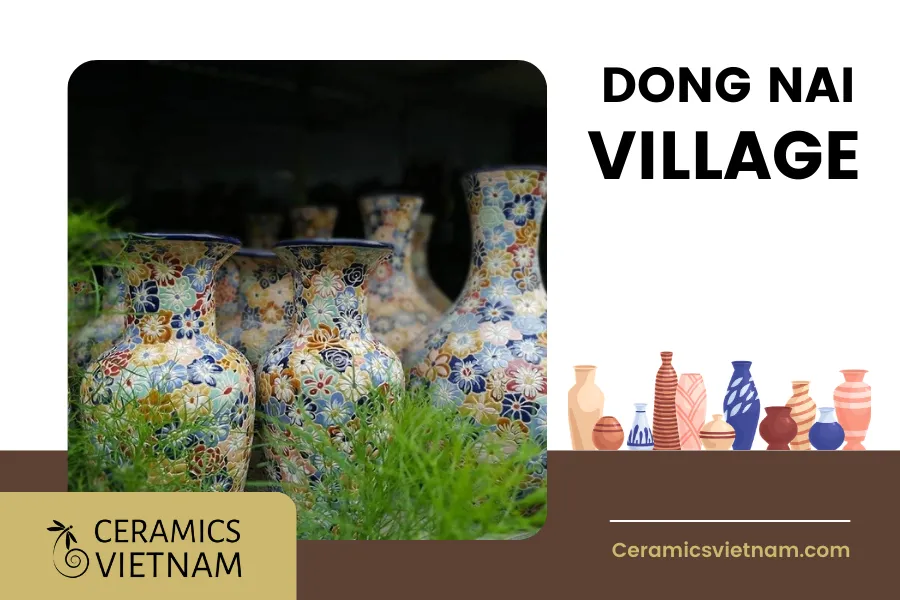
The golden Era of Bien Hoa pottery
Dong Nai ceramics on the global stage
Over the years, Dong Nai ceramics have not only survived but have thrived, finding their way into international markets in Southeast Asia and Europe. Their enduring fame can be attributed to both their outstanding quality and their diverse range of designs. Whether introducing innovative styles, intricate patterns, or a rich palette of colors, Dong Nai ceramics continue to exude the timeless charm of ancient porcelain.
A journey to Bien Hoa Dong Nai’s ceramic villages
To explore the world of Dong Nai ceramics, you can embark on a journey along the Saigon Expressway, heading to Bien Hoa from Ho Chi Minh City, a distance of approximately 30 kilometers. As you approach the Dong Nai River basin, you’ll be greeted by picturesque villages and kilns that emit a smoky ambiance into the sky. These are the ceramic villages of Bien Hoa, primarily concentrated in the southern part of Bien Hoa city, encompassing the communes of Hóa An, Vũ Hòa, Tân Vạn, Tân Hạnh, and Long Thành. Make note of these locations if you wish to explore further.
A visit to Bien Hoa Pottery Village promises an immersive experience. You can witness the entire ceramic production process, from selecting raw materials and shaping on pottery wheels or molds to intricate painting, glazing, and firing. Moreover, you’ll encounter a dazzling array of flower pots, statues, and other ceramic artistry, characterized by their exquisite and modern design sensibilities. Tân Vạn Pottery Village, one of the oldest ceramic craft villages in the South, offers a unique opportunity to observe these processes and admire the elegant, contemporary touches that adorn Dong Nai ceramics.
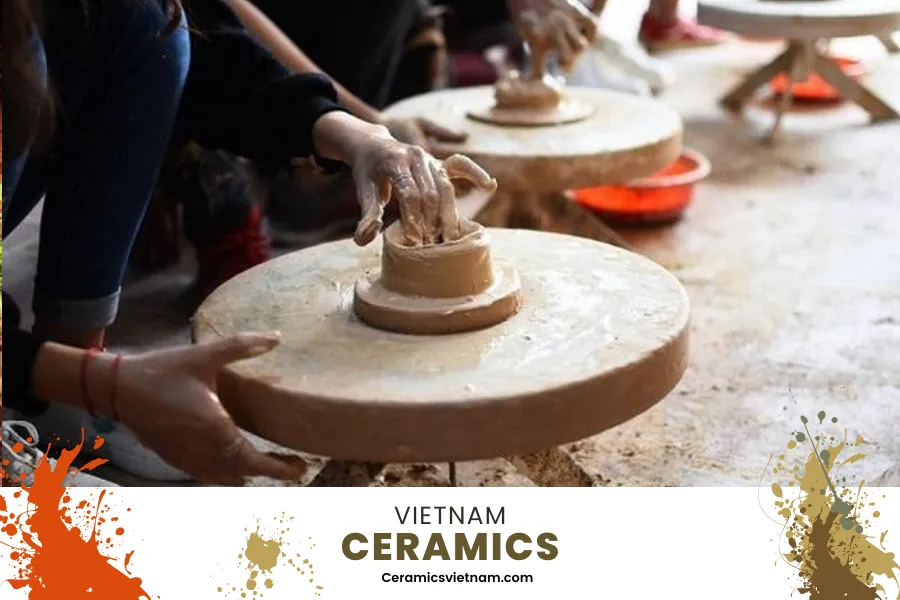
A journey to Bien Hoa Dong Nai’s ceramic villages
Today, Dong Nai ceramics continues to captivate both art enthusiasts and historians. Its enduring legacy reflects not only a craft but also a vibrant cultural heritage that has stood the test of time. The village remains a testament to the dedication of its artisans and the artistic ingenuity that has been cherished for over a century. Exploring Dong Nai pottery is not just a journey into artistry; it’s a journey into the heart of Vietnamese culture and tradition.
Dong Nai ceramic production process
The main raw material
The foundation of Dong Nai ceramics lies in its meticulous production process, driven by the careful selection of raw materials. The primary constituents used in crafting these exquisite pieces are kaolin and clay.
Kaolin and Clay Preparation: White clay, sourced from local deposits, forms the backbone of this art. It is meticulously processed, often being turned into a paste or liquefied state. This prepared clay mixture is then applied to molds. Notably, the molds used in Dong Nai pottery are crafted from plaster, chosen for its exceptional water-absorbing properties.
Molding and Drying: Once the clay has been shaped within the molds, the result is semi-finished ceramic products. To achieve the desired consistency and remove excess moisture, these semi-finished pieces are carefully sun-dried. This drying process continues until the pieces are completely devoid of moisture, rendering them more manageable for subsequent refinement.
Finishing Touches: The artisans take great care to perfect their creations. After the drying process, any remaining imperfections or excess material are meticulously removed, ensuring a smooth surface.
Artistic Embellishments: The hallmark of Dong Nai ceramics lies in its intricate patterns and captivating imagery. Skilled artists meticulously paint and carve these elements onto the semi-finished products, giving them their unique and artistic character.
Enameling and Firing: To seal and enhance the beauty of the ceramic pieces, they are carefully coated with enamel. This step not only provides a protective layer but also adds a glossy finish. Finally, the ceramics are ready for the firing process, where they are subjected to high temperatures that solidify their form and lock in the artistry.
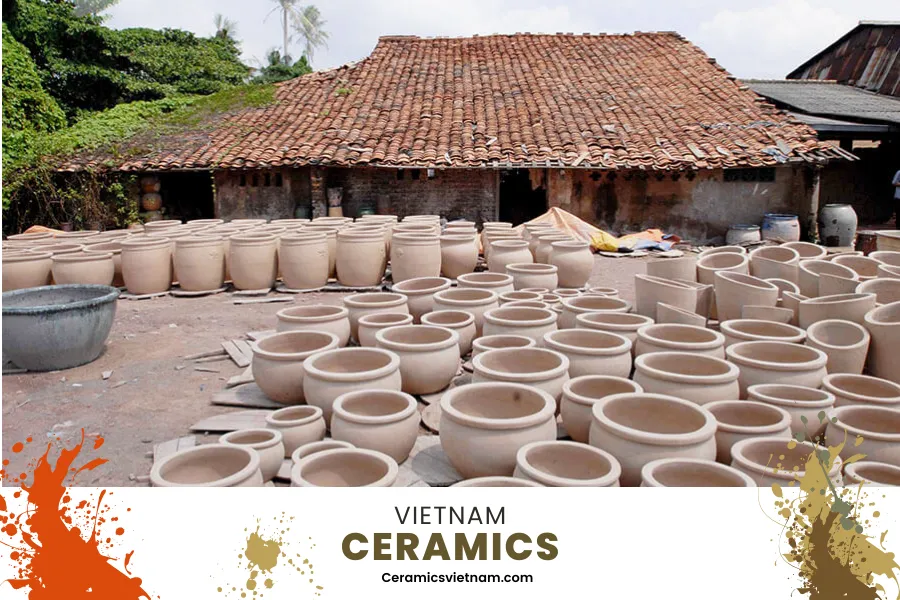
The primary constituents used in crafting these exquisite pieces are kaolin and clay
The Dong Nai ceramic production process is a fusion of time-honored techniques, artistic expertise, and meticulous craftsmanship. It is a testament to the village’s dedication to preserving its heritage while creating masterpieces that continue to captivate art lovers around the world.
The distinctive glazing process
One of the defining characteristics of Dong Nai ceramics lies in the meticulous art of glaze formulation and the high level of technical expertise possessed by the ceramic artisans. The glazing process, in particular, stands out as the most critical phase, demanding seasoned artisans with years of experience. This step is considered paramount as it significantly impacts the final product, ensuring its structural integrity and aesthetic appeal.
The Art of Glaze Application: Glaze application is an art in itself, requiring the skilled hands of experienced craftsmen. A critical aspect of this process is the selection and preparation of glazes. Artisans must master the delicate balance of ingredients to create glazes that not only enhance the ceramics’ visual appeal but also ensure their durability during the firing process. An oversight in glaze preparation can result in deformities or warping of the final product during firing.
Materials Matter: In the world of ceramics, the choice of materials is of paramount importance. Dong Nai ceramic artisans meticulously select the finest materials to ensure that the products meet the highest standards of quality. This material selection process encompasses various aspects, from the clay’s texture to the glaze’s composition. These choices are made to guarantee that each piece meets the desired aesthetic and functional criteria.
Guardians of Tradition: Ceramic artisans in Dong Nai are not just skilled craftsmen but also guardians of centuries-old traditions. They understand that their craft is an intricate blend of art and science, and their expertise is crucial in ensuring that each ceramic piece is a masterpiece. Their unwavering commitment to the craft, coupled with their ability to adapt and innovate, is what sets Dong Nai ceramics apart.
In summary, the essence of Bien Hoa ceramics is intricately tied to the art of glaze formulation and the technical prowess of its artisans. The glazing process, in particular, is a testament to the importance of experience and expertise in crafting ceramics of exceptional quality and enduring beauty. The artisans’ dedication to selecting the finest materials and preserving tradition ensures that each Bien Hoa ceramic piece not only meets high standards but also embodies the rich cultural heritage of the region.
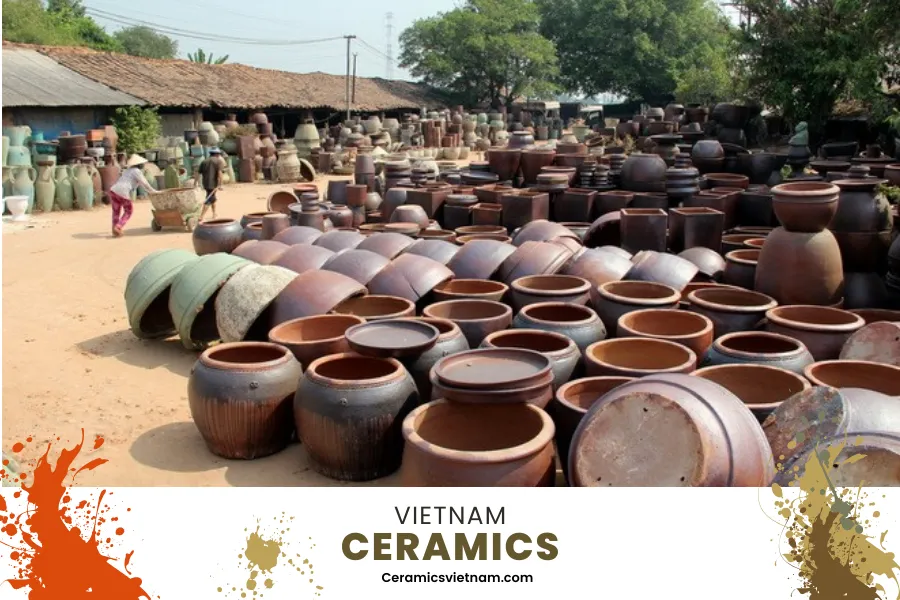
The distinctive glazing process of Dong Nai ceramics
Meticulous glazing dots
One of the defining features of Dong Nai ceramics lies in its meticulous glaze application, a process known for its intricacy and artistic significance. Each ceramic kiln in Dong Nai holds closely guarded secrets regarding their unique glaze-making techniques. This emphasis on preserving individual traditions is evident in the distinct decorative themes found on Dong Nai ceramics, often reflecting Chinese influences with motifs like the Four Gentlemen, Four Supernatural Creatures, or classical Chinese poetry. Additionally, Chăm cultural elements, such as depictions of deities like Vishnu and Shiva, add further depth to the ceramic artistry.
Additionally, the preparation of the glaze itself is equally critical and can significantly impact the aesthetics of the final product.
The Art of Yeast Preparation: Central to the glaze application is the yeast preparation technique. This aspect demands a deep understanding and skillful execution. An artisan’s proficiency in yeast preparation directly influences the outcome of the ceramic piece. A mistake or oversight in this stage can have a profound effect on the final appearance and quality of the product.
Guarded Secrets of Glaze Making: Each ceramic kiln in Dong Nai holds closely guarded secrets regarding their unique glaze-making techniques. These well-kept traditions have been passed down through generations, ensuring that the ceramics produced here possess not only exceptional utility but also unparalleled artistic value. The fusion of skill, tradition, and innovation in glaze application sets Dong Nai ceramics apart.
Characteristics of Dong Nai Ceramics: Dong Nai ceramics are characterized by their use of white glaze as a base, often serving as a canvas for intricate and brilliant textures. Furthermore, some designs incorporate blue glaze as a background, a striking contrast that is particularly employed in perforated ceramic products such as pedestals and porcelain elephants. This blending of colors and textures exemplifies the artistry and versatility inherent in Dong Nai ceramics, making each piece a masterpiece that seamlessly merges utility and aesthetic appeal.
In Dong Nai, the art of glaze application is not merely a step in the ceramic-making process; it is a testament to the dedication of its artisans and their commitment to preserving their cultural heritage while continuously innovating to create pieces of enduring beauty and value.
The firing method of Dong Nai ceramics
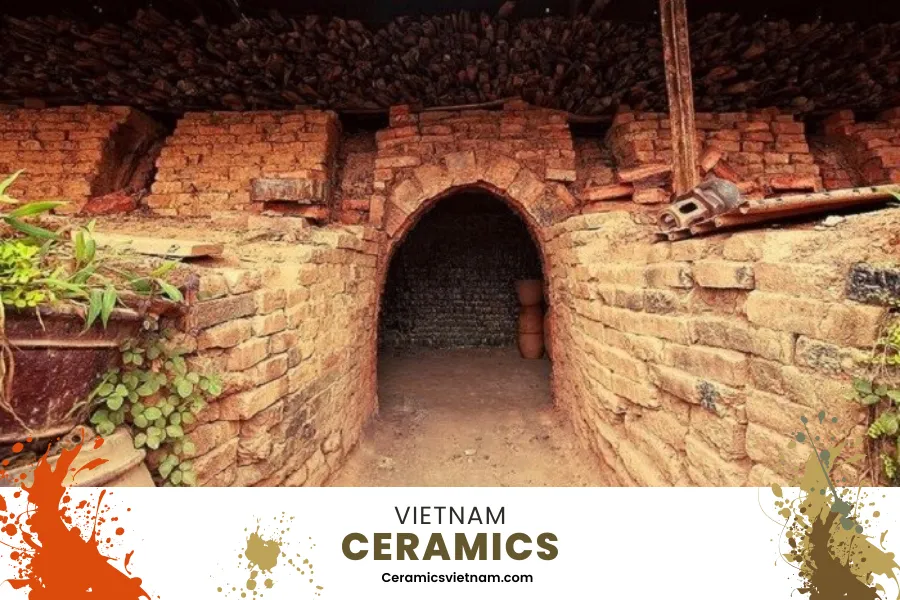
The firing method of Dong Nai ceramics
The firing stage in the creation of Dong Nai ceramics stands as a pivotal moment, holding the power to determine the ultimate success or failure of each crafted piece. This essential step encapsulates a fascinating blend of traditional wisdom and modern practice, shedding light on the unique character of Dong Nai ceramics.
Craft-Based Firing: Presently, ceramic production facilities in Dong Nai adhere to a time-tested practice of firing ceramics in the form of crafts. This method preserves the artisanal essence of the craft while imparting distinct characteristics to each piece. The choice of the firing process as a craft underscores the commitment to maintaining authenticity in the creation of these ceramics.
The Role of Firewood: Firewood stands as the primary fuel source in the firing process. This choice reflects a commitment to sustainable practices, as well as a nod to the age-old traditions that have sustained the art form for centuries. The use of firewood also contributes to the unique character of Dong Nai ceramics, infusing them with a sense of natural warmth and organic charm.
Kiln Mastery: The individuals responsible for overseeing the kilns are seasoned experts. While they may not rely on sophisticated instruments to measure temperature, their experience and intuition are the guiding forces. These skilled artisans gauge the temperature with a keen eye, ensuring remarkable precision in regulating the kiln’s heat. This hands-on approach to temperature control is a testament to the deep-rooted knowledge that has been passed down through generations.
In Dong Nai, the firing process is not just a technical step; it embodies the spirit of the region’s ceramic craftsmanship. It represents a harmonious balance between tradition and innovation, where skilled artisans ensure that every ceramic piece emerges from the kiln as a work of art, reflecting the rich heritage and cultural significance of Dong Nai ceramics.
Dong Nai ceramics, with its rich history spanning centuries, stands as a testament to the enduring spirit of craftsmanship and artistic ingenuity. This art form, rooted in tradition and innovation, has made Dong Nai a notable hub for ceramic excellence.
Read more













Leave a reply